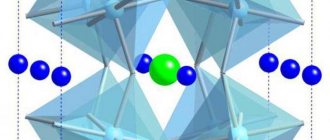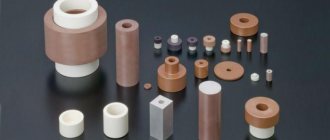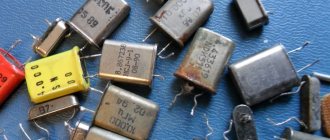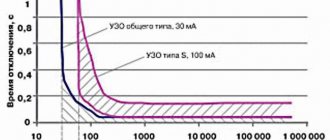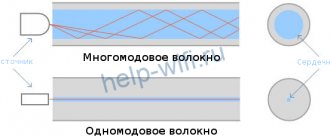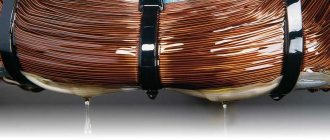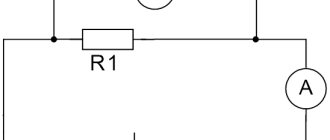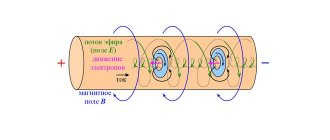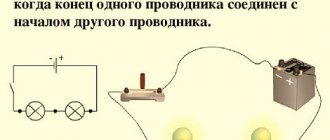What are conductors and dielectrics
Conductors are substances with free electrical charges that can move directionally under the influence of an external electric field. They have these features:
- metals and their melts;
- natural carbon (coal, graphite);
- electrolytes - solutions of salts, acids and alkalis;
- ionized gas (plasma).
The main property of materials: free charges - electrons in solid conductors and ions in solutions and melts, moving throughout the entire volume of the conductor, conduct an electric current. Under the influence of electrical voltage applied to the conductor, a conduction current is created. Resistivity and electrical conductivity are the main indicators of a material.
The properties of dielectric materials are opposite to conductors of electricity. Dielectrics (insulators) - consist of neutral atoms and molecules. They do not have the ability to move charged particles under the influence of an electric field. Dielectrics in an electric field accumulate uncompensated charges on the surface. They form an electric field directed into the insulator, polarization of the dielectric occurs.
As a result of polarization, charges on the surface of the dielectric tend to reduce the electric field. This property of electrical insulating materials is called the dielectric constant of the dielectric.
Dependence of conductor resistance on current frequency
When exposed to electric current, the induction of a magnetic field occurs inside a straight conductor and in the space surrounding it. Magnetic lines form concentric circles.
Alternating current distribution across the cross section
How to calculate amperes
If a current-carrying conductor is conditionally divided into several current filaments parallel to each other, then it can be established that the closer the current filament is to the axis of the conductor, the greater the magnetic flux that closes inside it covers it. The inductance of the filament and the inductive reactance are proportional to the magnetic flux associated with it.
In this regard, in threads with alternating current located inside the conductive substance, greater inductive reactance occurs than in threads located outside. An uneven current across the cross-section is formed, increasing from the axis to the surface of the conductor, which explains the increase in the resistance of the conductors to alternating current. This phenomenon is called the skin effect.
Due to the uneven distribution of current density, the resistance of the conductor increases. At a low frequency of 50 Hz and a small cross-section of copper wire, the phenomenon of surface effect is almost imperceptible. With a significant increase in the frequency and cross-section of the iron conductor, this phenomenon will be more active.
Note! The higher the frequency of the current in the circuit, the closer to the surface of the conductor the electrical charges are, and the more its resistance increases.
Characteristics and physical properties of materials
The parameters of the conductors determine the scope of their application. Main physical characteristics:
- electrical resistivity - characterizes the ability of a substance to prevent the passage of electric current;
- temperature coefficient of resistance - a value characterizing the change in indicator depending on temperature;
- thermal conductivity - the amount of heat passing per unit time through a layer of material;
- contact potential difference - occurs when two dissimilar metals come into contact, used in thermocouples to measure temperature;
- temporary tensile strength and tensile elongation depend on the type of metal.
Formula for determining conductor length
Ampere - what is it?
You can find the length of the conductor by directly measuring it, for example, with a tape measure. If you need to calculate the length of hidden electrical wiring in a home, you need to take into account that it is usually laid horizontally along the walls at a distance of 15-20 cm from the ceiling. Vertically, at right angles, make drops on switches and sockets. If the conductor is difficult to reach (grounding conductors) or is long, this method may be difficult to implement.
Then the length of the conductor is determined in a different way. To do this you need to prepare:
- construction tape,
- tester,
- calipers,
- table of electrical conductivity of metals.
First you need to measure the resistance of individual sections of electrical wiring. Next, determine the cross-section of the wire and the material from which it is made. Typically, aluminum or copper conductive materials are used in everyday life.
From the formula for determining resistance ( R = r * L * s), find the length of the conductor using the formula:
L = R / r*s,
Where:
- L – wire length,
- R is its resistance,
- r – resistivity of the material (for copper it ranges from 0.0154 to 0.0174 Ohm, for aluminum – from 0.0262 to 0.0278 Ohm),
- s – cross-sectional area of the wire.
Calculate the wire cross-section:
S = π/4 * D2,
Where:
- π – a number approximately equal to 3.14;
- D is the diameter measured with a caliper.
If you need to find the length of a wire wound into a coil, determine the length of one turn in meters and multiply by the number of turns.
If the coil is round, measure its diameter, multiply by the number π and the number of turns:
L = d * π * n,
Where:
- d – coil diameter,
- n – number of turns of wire.
Types and classification of dielectric materials
Insulators are divided into groups according to several criteria.
Classification according to the state of aggregation of a substance:
- hard - glass, ceramics, asbestos;
- liquid - vegetable and synthetic oils, paraffin, liquefied gas, synthetic dielectrics (silicon and organofluorine compounds freon, freon);
- gaseous - air, nitrogen, hydrogen.
Dielectrics can be of natural or artificial origin, organic or synthetic in nature.
Organic natural insulating materials include vegetable oils, cellulose, and rubber. They are characterized by low heat and moisture resistance and rapid aging. Synthetic organic materials - various types of plastic.
Inorganic dielectrics of natural origin include: mica, asbestos, muscovite, phlogopite. The substances are resistant to chemical attack and can withstand high temperatures. Artificial inorganic dielectric materials - glass, porcelain, ceramics.
What is a semiconductor
By designation, a semiconductor is a substance whose electrical conductivity is less than that of a metal and greater than that of a dielectric.
Semiconductors
The difference between a semiconductor is that its electrical conductivity depends on the temperature regime and the volume of impurities in the composition. The material has both conductive and dielectric characteristics.
As the temperature increases, the electrical conductivity of a substance increases, and the resistance level decreases. As the temperature decreases, the resistance tends to infinity.
Note! When the temperature reaches zero, the semiconductor behaves as an insulator.
Due to their unique properties, semiconductors are used in many industries: low-power SMD on printed circuit boards, and high-power devices, for example, thyristors in power converter technology.
Why dielectrics do not conduct electricity
Low conductivity is due to the structure of dielectric molecules. Particles of matter are closely connected to each other, cannot leave the confines of the atom and move throughout the entire volume of the material. Under the influence of an electric field, the particles of an atom can become slightly looser and become polarized.
Depending on the polarization mechanism, dielectric materials are divided into:
- non-polar - substances in different states of aggregation with electronic polarization (inert gases, hydrogen, polystyrene, benzene);
- polar - have dipole-relaxation and electronic polarization (various resins, cellulose, water);
- ionic - solid dielectrics of inorganic origin (glass, ceramics).
Properties of dielectrics
The choice of dielectrics should be made in accordance with their properties:
- Electrical: breakdown voltage (at which breakdown occurs), electrical strength (field strength at which breakdown occurs);
- Physico-chemical: resistance to heat (the ability to withstand operating temperatures for a long time), cold resistance (the ability to withstand temperature changes), wettability (the ability to reject moisture);
- Chemical: resistance to aggressive environments, solubility in varnishes, possibility of gluing;
- Mechanical: radiation resistance, viscosity (for liquid dielectrics), corrosion protection, tensile strength, possibility of tooling.
Zone theory
The band theory of solids is the theory of the movement of valence electrons in the potential field of a crystal lattice. Quantum mechanics believes that free electrons can have any energy, the spectrum of which is continuous.
The electrons of isolated atoms have a certain discrete amount of energy. When individual atoms combine into molecules and form a substance, the electronic levels of the atom shift. Thus, from the energy levels of individual atoms in a solid, bands of energy level zones are formed.
The upper filled band, the valence band, corresponds to the energy level of the valence electrons of the outer shell. The closest to it, unfilled, is the conduction band. The relative position of both zones determines the processes occurring in a solid, and materials are classified into groups: conductors, semiconductors, dielectrics.
Zone classification
In conductors, the conduction band and valence band are combined. The resulting overlap zone allows the electron to move freely when receiving even small amounts of energy.
In semiconductors, the bands do not overlap. The distance between them, called the band gap, is less than 2.0 eV. At zero temperature, there are no electrons in the conduction band, and the valence band is filled with them. As the temperature increases, some electrons are thrown into the conduction band due to thermal motion. The semiconductor becomes electrically conductive.
In dielectrics, the zones, just like in semiconductors, do not overlap. The band gap here is more than 2.0 eV. In order to transfer electrons from the valence zone to the conduction zone, it is necessary to significantly increase the temperature. At low degrees, no electric current is conducted.
Superconductivity
The property of a material to have zero electrical resistance at a temperature below a certain value is called superconductivity.
For some conductive substances, this ability occurs at cold temperatures close to the chemical state of liquid helium.
In 1986, substances with high-temperature superconductivity were discovered. For example, ceramics made of oxygen, barium, copper, lanthanum do not conduct current under normal conditions, but due to heating they become a superconductor.
In practice, substances are used that transmit electric current at 58 degrees Kelvin or more, that is, at a temperature above the boiling point of nitrogen.
Solid high-temperature superconductors are most often used. Liquid and gaseous ones are used less frequently. All these materials are necessary for the manufacture of modern electrical devices of various capacities.
